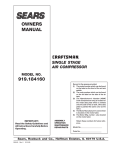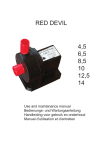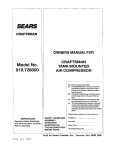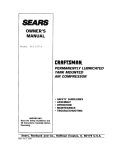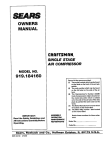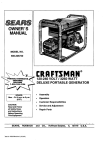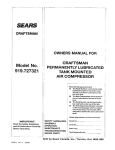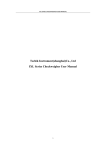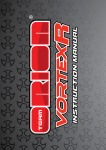Download Craftsman 919.184160 Troubleshooting guide
Transcript
SE,IM $
OWNERS
MANUAL
CRAFTSMAN.
SINGLE STAGE
AIR COMPRESSOR
MODEL
NO.
919.184160
Record in the spaces provided.
(1) The model number which can be found
on the label on the front of the air tank
saddle.
(2) The code number which can be found
on the foil label on the side of the air
tank.
(3) The Manufacturer's Number (ASME
Code Compressors only) is located on
the metal data plate which is welded
onto the side of the air tank, (This data
plate is painted the same color as the
tank.)
(4) The Motor Manufacturer's name which
is located on the motor label.
(5) The Motor Mfg. number- also located
on the motor label.
ASSEMBLY
OPERATION
MAINTENANCE
REPAIRPARTS
IMPORTANT:
Read the Safety Guidelines
and
All Instructions
Carefully Before
Operating.
Retain these numbers for future reference.
ModeINo.
Code
Sears,
D20410
Rev 0
Roebuck
2/16/00
and
Co.,
Hoffman
Estates,
No.
IL 60179
U.S.A.
Page
SAFETY GUIDELINES ...........................................................................
WARNING CHART .................................................................................
SPECIFICATION CHART ......................................................................
GLOSSARY ............................................................................................
ACCESSORIES FOR USE WITH
SEARSAIR COMPRESSORS ..........................................................
2
3-5
6
6
GENERAL INFORMATION ....................................................................
DESCRIPTION OF OPERATION ...........................................................
INSTALLATION AND BREAK-IN PROCEDURES .................................
Location of AirCompressor ..............................................................
Piping ...............................................................................................
Lubrication and Oil ...........................................................................
7
7
7-9
7
8
8
Wiring Instructions ............................................................................
Wiring Diagram .................................................................................
Break-In Procedures .........................................................................
OPERATING PROCEDURES .................................................................
MAINTENANCE .....................................................................................
Air Compressor ................................................................................
Air Filter - Inspection and Replacement ............................................
Oil - Checking and Changing ............................................................
Air Tank- Draining Water ..................................................................
Check Valve - Inspection and RepFacement .....................................
Safety Valve Inspecti0n ....................................................................
Motor ................................................................................................
Belt - Replacement ..........................................................................
Pulley and Flywheel -Alignment .......................................................
6
8
8
9
9
9-11
9
9
10
10
10
10
10
10
11
TROUBLESHOOTING GUIDE .............................................................
11-12
AIR COMPRESSOR DIAGRAM .............................................................
14
Parts List ..........................................................................................
15
COMPRESSOR PUMP DIAGRAM ........................................................
16
Parts List ..........................................................................................
17
HOW TO ORDER REPAIR PARTS .............................................
Back Cover
WARRANTY ...............................................................................
BackCover
This manual contains information that is important for you to know and understand. This information relates to
protecting YOUR SAFETY and PREVENTING EQUIPMENT PROBLEMS. To help you recognize this information,
we use the symbols to the right. Please read the manual and pay attention to these sections.
DANG ER indicates an imminently hazardous situation
which, if not avoided, will result in death or serious
in Lu__.
CAUTION indicates a potentially hazardous situation
which, if not avoided, _
result in minor or rnoder-
WARNING indicates a potentially hazardous situa*
tion which, if not avoided, could result in death of
serious injury.
CAUTION used without the safety alert symbol indicates a potentially hazardous situation which, if not
avoided, _
result in property damage.
D20410
Rev 0
2/16/00
2 --
Eng
SAVE THESE INSTRUCTIONS
--
IMPROPER
OPERATION OR MAINTENANCE
OF THIS PRODUCT COULD RESULT tN SERIOUS INJURY AND PROPERTY
DAMAGE. READ AND UNDERSTAND
ALL WARNINGS AND OPERATING INSTRUCTIONS
BEFORE USING THIS EQUIPMENT.
WHAT
CAN HAPPEN
HOW TO PREVENT IT
IT IS NORMAL FOR ELECTRICAL CONTACTS WITHIN THE
MOTOR AND PRESSURE SWITCH TO SPARK.
ALWAYS OPERATE THE COMPRESSOR
LATED AREA FREE OF COMBUSTIBLE
GASOLINE OR SOLVENT VAPORS.
IF ELECTRICAL SPARKS FROM COMPRESSOR COME INTO
CONTACT WITH FLAMMABLE VAPORS, THEY MAY IGNITE,
CAUSING FIRE OR EXPLOSION.
_F SPRAYING FLAMMABLE MATERIALS, LOCATE COMPRESSOR AT LEAST 20 FEET AWAY FROM SPRAY AREA. AN
ADDITIONAL LENGTH OF HOSE MAY BE REQUIRED.
STORE FLAMMABLE MATERIALS
AWAY FROM COMPRESSOR.
RESTRICTING ANY OF THE COMPRESSOR VENTILATION
OPENINGS WILL CAUSE SERIOUS OVERHEATING AND
COULD CAUSE FIRE.
IN A WELL VENTIMATERIALS,
IN A SECURE
LOCATION
NEVER PLACE OBJECTS AGAINST OR ON TOP OF COMPRESSOR,
OPERATE COMPRESSOR IN AN OPEN AREA AT
LEAST 12 INCHES AWAY FROM ANY WALL OR OBSTRUCTION THAT WOULD RESTRICT THE FLOW OF FRESH AIR TO
THE VENTILATION OPENINGS.
OPERATE COMPRESSOR IN A CLEAN, DRY, WELL VENTILATED AREA. DO NOT OPERATE UNIT INDOORS OR IN ANY
CONFINED AREA.
UNATTENDED OPERATION OF THIS PRODUCT
RESULT IN PERSONAL INJURY OR PROPERTY
COULD
DAMAGE.
ALWAYS REMAIN IN ATTENDANCE
WHEN IT IS OPERATING.
WITH THE PRODUCT
.s,o,
ou,s,.o
AIR TANK:
THE FOLLOWING
CONDITIONS
COULD LEAD TO A WEAKENING
OF THE TANK, AND RESULT IN A
VIOLENT TANK EXPLOSION
AND COULD CAUSE PROPERTY
DAMAGE OR SERIOUS INJURY.
WHAT CAN HAPPEN
HOW TO PREVENT IT
1.FAILURE
TO PROPERLY DRAIN CONDENSED WATER
FROM THE TANK, CAUSING RUST AND THINNING OF THE
STEEL TANK.
DRAIN TANK DALLY OR AFTER EACH USE, IF TANK DEVELOPS A LEAK, REPLACE IT IMMEDIATELY WITH A NEW TANK OR
REPLACE THE ENTIRE COMPRESSOR.
2 MODIFICATIONS
NEVER DRILL INTO, WELD, OR MAKE ANY MODIFICATIONS
TO THE TANK OR ITS A_-ACHMENTS.
OR ATTEMPTED
REPAIRS TO THE TANK.
3. UNAUTHORIZED MODIFICATIONS
TO THE UNLOADER
VALVE, SAFETY VALVE, OR ANY OTHER COMPONENTS
WHICH CONTROL TANK PRESSURE.
THE TANKIS DESIGNED TO WITHSTAND SPECIFIC OPERATING
PRESSURES,
NEVER MAKE ADJUSTMENTS
OR PARTS
SUBSTITUTIONS
TO ALTER THE FACTORY SET OPERATING
PRESSURES.
4 EXCESSIVE VIBRATION CAN WEAKEN THE AIR TANK
AND CAUSE RUPTURE OR EXPLOSION.
ATTACHMENTS
& ACCESSORIES:
EXCEEDING
THE PRESSURE
RATING
OF AIR TOOLS,
SPRAY
GUNS, AIR OPERATED
ACCESSORIES,
TIRES AND OTHER
INFLATABLES
CAN CAUSE
THEM
TO EXPLODE
OR FLY
APART,
AND COULD
RESULTIN
SERIOUSINJURY
FOR ESSENTIAL CONTROL OF AIR PRESSURE, YOU MUST
INSTALL A PRESSURE REGULATOR AND PRESSURE GAUGE
TO THE AIR OUTLET OF YOUR COMPRESSOR. FOLLOW THE
EQUIPMENT MANUFACTURERS
RECOMMENDATION
AND
NEVER EXCEED THE MAXIMUM ALLOWABLE PRESSURE
RATING OF ATrACHMENTS,
NEVER USE COMPRESSOR TO
INFLATE SMALL LOW-PRESSURE
OBJECTS SUCH AS
CHILDREN'S
TOYS, FOOTBALLS, BASKETBALLS. ETC.
3 -- Eng
D20410
Rev. 0
2/!6/00
RISK FROM
FLYING
OBJECTS
WHAT CAN HAPPEN
HOWTO PREVENTIT
ALWAYS WEAR ANSI Z87.1 APPROVED SAFETY GLASSES
WITH SIDE SHIELDS WHEN USING THE COMPRESSOR.
THE COMPRESSED AIR STREAM CAN CAUSE SOFT TISSUE
DAMAGE TO EXPOSED SKIN AND CAN PROPEL DIRT, CHIPS,
LOOSE PARTICLES AND SMALL OBJECTS AT HIGH SPEED,
RESULTING IN PROPERTY DAMAGE OR PERSONAL INJURY
NEVER POINT ANY NOZZLE OR SPRAYER TOWARD ANY
PART OF THE BODY OR AT OTHER PEOPLE OR ANIMALS.
ALWAYS TURN THE COMPRESSOR OFF AND BLEED PRESSURE FROM THE AIR HOSE AND TANK BEFORE ATTEMPTING
MAINTENANCE, ATTACHING TOOLS OR ACCESSORIES
RISK TO BREATHING
WHAT CAN HAPPEN
HOW TO PREVENT IT
THE COMPRESSED AIR FROM YOUR COMPRESSOR IS NOT
SAFE FOR BREATHING!
THE AIR STREAM MAY CONTAIN
CARSON MONOXIDE, TOXIC VAPORS OR SOLID PARTICLES
FROM THE TANK.
ALWAYS OPERATE AIR COMPRESSOR OUTSIDE
IN A CLEAN,
WELL VENTILATED AREA. AVOID ENCLOSED AREAS SUCH AS
GARAGES, BASEMENTS, STORAGE SHEDS, WHICH LACK A
STEADY EXCHANGE OF AIR. KEEP CHILDREN, PETS AND
OTHERS AWAY FROM AREA OF OPERATION
NEVER INHALE AIR FROM THE COMPRESSOR EITHER
DIRECTLY OR FROM A BREATHING DEVICE CONNECTED
THE COMPRESSOR
TO
WORK IN AN AREA WITH GOOD CROSS-VENTILATION.
READ
AND FOLLOW THE SAFETY INSTRUCTIONS
PROVIDED ON
THE LABEL OR SAFETY DATA SHEETS FOR THE MATERIAL
YOU ARE SPRAYING. USE A NIOSH/MSHA APPROVED
RESPIRATOR DESIGNED FOR USE WITH YOUR SPECIFIC
APPLICATION.
SPRAYED MATERIALS SUCH AS PAtNT, PAINT SOLVENTS,
PAINT REMOVER, INSECTICIDES, WEED KILLERS, CONTAIN
HARMFUL VAPORS AND POISONS.
WHATCANHAPPEN
HOWTO PREVENTIT
YOUR AIR COMPRESSOR
IS POWERED BY ELECTRICITY.
LIKE ANY OTHER ELECTRICALLY POWERED DEVICE, IF IT IS
NOT USED PROPERLY IT MAY CAUSE ELECTRIC SHOCK.
NEVER OPERATE THE COMPRESSOR
RAINING OR IN WET CONDITIONS.
REPAIRS ATTEMPTED BY UNQUALIFIED PERSONNEL CAN
RESULT IN SERIOUS INJURY OR DEATH BY ELECTROCUTION.
ANY ELECTRICAL WIRING OR REPAIRS REQUIRED ON THIS
PRODUCT SHOULD BE PERFORMED BY AUTHORIZED
SERVICE CENTER PERSONNEL IN ACCORDANCE WITH
NATIONAL AND LOCAL ELECTRICAL CODES
ELECTRICAL GROUNDING:
FAILURE TO PROVIDE ADEQUATE
GROUNDING TO THIS PRODUCT COULD RESULT IN SERIOUS
INJURY OR DEATH FROM ELECTROCUTION.
SEE GROUNDING INSTRUCTIONS
MAKE CERTAIN THAT THE ELECTRICAL CIRCUIT TO WHICH
THE COMPRESSOR IS CONNECTED PROVIDES PROPER
ELECTRICAL GROUNDING,
CORRECT VOLTAGE AND
ADEQUATE FUSE PROTECTION.
D20410
Rev
0
2/16/00
NEVER OPERATE COMPRESSOR
REMOVED OR DAMAGED,
4 -- Er)g
OUTDOORS WHEN IT IS
WITH COVER
COMPONENTS
RISK FROM
MOVING
PARTS
WHAT CAN HAPPEN
HOW TO PREVENT
MOVING PARTS SUCH AS THE PULLEY, FLYWHEEL AND BELT
CAN CAUSE SERIOUS INJURY IF THEY COME INTO CONTACT
WITH YOU OR YOUR CLOTHING,
NEVER OPERATE THE COMPRESSOR WITH GUARDS OR
COVERS WHICH ARE DAMAGED OR REMOVED,
ATTEMPTING
TO OPERATE COMPRESSOR WITH DAMAGED
OR MISSING PARTS OR ATTEMPTING
TO REPAIR COMPRESSOR WITH PROTECTIVE SHROUDS REMOVED CAN
EXPOSE YOU TO MOVING PARTS AND CAN RESULT IN
SERIOUS INJURY.
ANY REPAIRS REQUIRED ON THIS PRODUCT SHOULD BE
PERFORMED BY AUTHORIZED SERVICE CENTER PERSONNEL.
IT
RISK OF BURNS
WHAT
CAN HAPPEN
HOW TO PREVENT IT
TOUCHING EXPOSED METAL SUCH AS THE COMPRESSOR
HEAD OR OUTLET TUBES, CAN RESULT IN SERIOUS BURNS,
NEVER TOUCH ANY EXPOSED METAL PARTS ON COMPRESSOR DURING OR IMMEDIATELY AFTER OPERATION. COMPRESSOR WILL REMAIN HOT FOR SEVERAL MINUTES AFTER
OPERATION.
DO NOT REACH AROUND PROTECTIVE SHROUDS OR A]-FEMPT
MAINTENANCE UNTIL UNIT HAS BEEN ALLOWED TO COOL.
RISK OF FALLING
WHAT
CAN
HAPPEN
HOWTO
A PORTABLE COMPRESSOR CAN FALL FROM A TABLE,
WORKBENCH OR ROOF CAUSING DAMAGE TO THE COMPRESSOR AND COULD RESULT IN SERIOUS INJURY OR
DEATH TO THE OPERATOR,
RISK OF PROPERTY
Damage
TRANSPORTING
to Vehicle
WHATCANHAPPEN
OIL CAN LEAK OR SPILL AND
BREATHING
HAZARD,
SERIOUS
ESW-99
Surfaces)
HOW TO PREVENT IT
ALWAYS PLACE COMPRESSOR ON A PROTECTIVE MAT WHEN
TRANSPORTING TO PROTECT AGAINST DAMAGE TO VEHICLE
FROM LEAKS. REMOVE COMPRESSOR FROM VEHICLE
IMMEDIATELY UPON ARRIVAL AT YOUR DESTINATION.
COULD
RESULT
IN FIRE OR
INJURY
OR DEATH CAN
RESULT.
OIL LEAKS WILL DAMAGE
CARPET,
SURFACES
rN VEHICLES
OR TRAILERS
IT
ALWAYS OPERATE COMPRESSOR IN A STABLE SECURE
POSITION TO PREVENT ACCIDENTAL MOVEMENT OF THE
UNIT. NEVER OPERATE COMPRESSOR ON A ROOF OR
OTHER ELEVATED POSITION.
USE ADDITIONAL AIR HOSE
TO REACH HIGH LOCATIONS.
DAMAGE WHEN
COMPRESSOR
(Fire, Inhalation,
PREVENT
PAINT
OR OTHER
-- 9/26/99
5 --
Eng
D20410
Rev 0
2/16/00
Model No.
Max. Developed HP
Displacement CFM at Max. Pressure
Bore
Stroke
Vortage - Single Phase
Minimum Branch Circuit Requirement
*Fuse Type
Amperage at Max. Pressure
Air Tank Capacity - Gallons
Approximate Cut-in Pressure
Approximate Cut-out Pressure
SCFM@ 90 psig
SCFM@ 40 psig
UL Listed
*A circuit breaker
is preferred.
Use only a fuse
circuit the air compressor
is operated
on.
or circuit
CFM: Cubic feet per minute.
919.184160
6.5
15
2 7/8
2"
220
20 amp
Fusetron Type "T"
15
60 gal ASME
100
125
10.5
13.0
Yes
breaker
that
is the same
rating
as the branch
Cut-Out Pressure: When you turn on your air compressor and it begins to run, air pressure in the air tank begins
to build. It builds to a certain high pressure before the
motor automatically shuts off - protecting your air tank
from pressure higher than its capacity. The high pressure
at which the motor shuts off is called "cut-out pressure."
SCFM: Standard cubic feet per minute; a unit of measu re
of air delivery.
PSIG: Pounds per square inch gauge; a unit of measure
of pressure.
ASME: American Society of Mechanical Engineers; made,
tested, inspected and registered to meet the standards
of the ASME.
Cut-In Pressure: While the motor is off, air tank pressure
drops as you continue to use your accessory. When the
tank pressure drops to a certain low level the motor will
re-start automatically. The low pressure at which the
motor automatically re-starts is called "cut-in pressure."
UL Listed: Underwriters Laboratories; samples of compressor outfits taken from production were submitted to
UL and found to comply with their requirements for
design and performance.
To Lock-Out Power: Place a lock on the line power
switch so no one else can turn on the power.
The following accessories are available through the current Power and Hand Tool Catalog or fuIFline Sears stores.
•
SPRAY GUNS
•
PAINT TANKS
•
BLOW GUNS
•
AIR TANKS
•
AIR CAULKING
GUNS
•
INFLATOR KITS
WASHER GUNS
•
QUICK CONNECTOR
•
Sanders
Drills
SETS
•
AIR POWERED
•
SAND BLASTERS
•
AIR BRUSHES
•
(various sizes)
AIR PRESSURE REGULATORS
IN LINE FILTERS
•
OIL FOG LUBRICATORS
•
• TIRE AIR CHUCKS
D204!0
Rev 0
2/16/00
AIR TOOLS
"Impact
Wrenches
Hammers
•
AIR HOSE:
1/4", 3/8" OR 1/2"
in various
6 --
Eng
lengths
I.D.
You have purchased an air compressor unit consisting of
a two cylinder, single stage air compressor pump, an
ASM Eair tank, associated controls and instruments. This
air compressor must be permanently mounted in place.
Your air compressor can be used for operating paint
spray guns, air tools, caulking guns, grease guns, air
brushes, sandblasters, inflating tires and plastic toys,
spraying weed killers, insecticides, etc. An air pressure
regulator is usually necessary for most of these applications. Regulators can be purchased from most Sears
stores or through the current Sears Power and Hand Tool
Catalog.
Air Compressor
Pump: To compress air, the pistons
move up and down in the cylinders. On the downstroke,
air is drawn in through the air intake filter and then through
the air intake valves. The exhaust valve remains closed.
On the upstroke of the piston, air is compressed. The
intake valves close and compressed air is forced out
through the exhaust valves, through the outlet tube,
through the check valve and into the air tank. Working air
is not available until the compressor has raised air tank
pressure above that required at the air outlet.
Check Valve: When the air compressor is operating, the
check valve is "open," allowing compressed airto enter
the air tank. When the air compressor reaches "cut-out"
pressure, the check valve "closes," allowing air pressure
to remain inside the air tan k. If the air is not unloaded, the
motor will try to start, but will be unable to. The check
valve allows the motor to re-start freely.
Location
of the Air Compressor
Operate the air compressor in a clean, dry and well
ventilated area. The air intake filter must be kept clear of
obstructions which could reduce air delivery of the air
compressor. The air compressor should be located at
least 12" away from walls or otherobstructions that could
interfere with the flow of air through the fan bladed
flywheel. The air compressor crankcase and head are
Separate air transformers which combine the functions of
air regulation and/or moisture and dirt removal should be
used where applicable.
Some form of piping or shut-off valve must be installed
before operating the air compressor. A 1/2" NPT shut-off
globe valve should be installed at the air compressor
tank. Do not use a ball valve.
Pressure Switch: The pressure switch automatically
starts
the motor when the air tank pressure drops below the
factory set "cut-in" pressure, it stops the motor when the
air tank pressure reaches the factory set "cut-out"
pressure.
Pressure Release Valve: The pressure release valve is
designed to automatically release compressed air from
the compressor head and the outlet tube when the air
compressor reaches "cut-out" pressure or is shut off. If
the air is not released, the motor will try to start but will
be unable to. The pressure release valve allows the
motor to restart freely. When the motor stops running,air
will be heard escaping for a few seconds. No air should
be heard leaking when the motor is running.
SafetyValve: if the pressure switch does not shut off the
air compressor at or near its cut-out pressu re setting, the
safety valve will protect against high pressure by "popping out" at its factory set pressure (slightly higher than
the pressure switch cut-out setting).
designed with fins to provide proper cooling. If the
humidity is high, a Sears air filter can be installed to
remove excessive moisture.
The air compressor should be as near to air outlets as
possible in order to avoid long pipe lines. Do not placethe
air compressor where heat is excessive.
7 -- Eng
020410
Rev
0
2/16/00
top of the oil fill hole. (It must not be allowed to be lower
than 3/8" - 6 threads down - from the top.) When filling the
crankcase, the oil flows very slowly. If the oil is added too
quickly, it will overflow and appear to be full. (Crankcase
oil capacity is 16 fluid ounces.) Under winter-type conditions use SAE 10W oil. (Multi-viscosity oil - 10W30 - will
leave carbon deposits on critical components reducing
performance and compressor life.) Replace oil fill plug.
EXCESSIVE VIBRATION MAY WEAKEN THE
AIR TANK AND CAUSE AN EXPLOSION.
THE OUTFIT MUST BE MOUNTED
AS
DESCRIBED
AND ILLUSTRATED
BELOW.
SS-IE2E-CD
3t8 FLAT
(SUPPUED
ON LEGS AS PART
WASHER
OF PACKAG4NG)
I
Wiring
WASHER
(NOT
IF NECESSARY
"_
FLOOR
SUPPLIED)
IMPROPER
GROUNDING
CAN RESULT IN
ELECTRICAL
SHOCK. WIRING OF THE
PRESSURE SWITCH, ELECTRIC MOTOR
AND MANUAL ON/OFF SWITCH SHOULD
BE DONE BY A LICENSED ELECTRICIAN
IN ACCORDANCE
WITH NATIONAL AND
LOCAL CODES AND ORDINANCES.
LINE
X
SCREW
ANCHOR FOR CONC_I_TE
{NO'_ SU PPLIED_
1.
2.
Instructions
To prevent added current draw and motoroverheating we
recommend the use of 12 gauge (AWG) wire, not exceeding a 70 foot length. The wire must be rated at a minimum
temperature of 75 ° C.
The air compressor must be bolted to the floor.
Bolting holes are provided in the base feet.
Mount the air compressor on a sorid level foundation
with no strain to the air tank feet. Solid shims may
be used if necessary.
When connecting wires, make sure that: (1) the electrical
box is large enough; (2) service is of adequate amperage
rating; (3) the supply line has the same electrical characteristics (voltage, cycles and phase) as the motor; (4) the
line wire is the proper size and (5) no other equipment is
operated from the same line. Various national and local
codes and standards have been set up covering electrical apparatus and wiring. These should be consulted and
observed. Our recommended wire sizes may be smaller
than the minimum set up by local ordinances. If so, the
larger size wire should be used to prevent excessive line
voltage drop. For wiring instructions, see the diagram
inside the pressure switch cover.
Piping
_l[o]_l
Plastic or PVC pipe is not designed for use
with compressed air. Regardless of its
indicated pressure rating, plastic pipe can
burst from air pressure. Use only metal pipe
for air distribution lines.
ff a pipe line is necessary, use pipe that is the same size
as the air tank valve. Piping that is too small will restrict
the flow of air. If piping is over 100 feet long, use the next
larger size. Bury underground lines below the frost line
and avoid pockets where condensation can gather and
freeze. Apply pressure before underground lines are
covered to make sure all pipe joints are free of leaks.
Lubrication
and
._oJU
r,==tu._
WALLMOUNTED
NCTIONBOX
R DISCONNECT
LIQUIDTITEFLEXIBLE
, METALCONDUITWITH
GROUNDLEAD
Oil
_
t
_
CONDUITELBOW
_tT@_nji[o] _I
Compressors are shipped without oil. Do not attempt to
operate this air compressor without first adding oil to the
crankcase.
Place unit on a level surface. Remove oil fill plug and
slowly add a special compressor
oil such as Sears 916426 or SAE-20-20W SF motor oil until it is even with the
D20410
Rev 0
2/16/00
8 -- Eng
r
Electrical wiring must be located away from hot surfaces
such as the compressor head, compressor cylinder or
compressor outlet tube.
Break-In
Procedures
i rR[_'_klJi d[o]_I
Serious damage may result if the following
break-in instructions are not closely followed,
This procedure is required only once; before the air
compressor is put into service. Some form of piping or
shut-off valve must be installed before beginning the
break-in procedure. A 1/2" NPT shut-off globe valve
should be installed at the air compressor tank. Do not
use a ball valve,
1,
2.
1.
2.
Recheck compressor wiring. Make sure wires are
secure at all terminal connections. Free all contacts
of loose wire cuttings, etc.
Check oil level in the crankcase before operation.
The oil level should be even with the top of the fill
hole and must not be allowed to be lower than 3/8"
(six threads down) from the top at any time. Add oil
if level is low.
3.
4.
5.
6.
7.
8.
Your compressor is now ready for use.
Before attaching an air hose or accessory, make
sure the pressure switch OFF/AUTO lever is in the
"OFF" position.
Attach hose and accessory.
TOO MUCH AIR PRESSURE CAUSES A
HAZARDOUS
RISK OF BURSTING. CHECK
THE MANUFACTURER'S
MAXIMUM
PRESSURE RATING FOR AIR TOOLS AND
ACCESSORIES.
THE REGULATOR
OUTLET
PRESSURE MUST NEVER EXCEED THE
MAXIMUM
PRESSURE
RATING.
Open the shut-off valve fully, to permit air to escape
and to prevent pressure build-up in the air tank.
Turn ONtheaircompressor.
Run the air compressor for 30 minutes to seal the
rings and lubricate all internal surfaces.
Check all air line fittings and connections/piping for
air leaks by applying a soap solution. Correct as
necessary. Even minor leaks can cause this air
compressor to overwork, resulting in premature
break-down or inadequate performance.
Check for excessive vibration and noise. Adjust air
compressor belt guard as necessary to eliminate
chatter. Re-adjust or shim the air compressor feet,
if necessary for proper level.
Close the shut-off valve and let the air compressor
pump up to cut-out pressure. Turn the air compressor off and check oil level. Add oil if necessary.
Connect the air hose to the air outlet adapter.
IVt_[o,7_a]i
d[o]_1
Serious damage may result if the following
break-in instructions are not closely followed. Compressed
air from the outfit may
contain water condensation and oil mist.
Do not spray unfiltered air at an item that
could be damaged. Some air operated tools
or devices may require filtered air. Read the
instructions for the air tool or device.
3.
Turn the compressor on and allow tank pressure to
build. The motor will stop when tank pressure
reaches cut-out pressure.
Your outfit is ready for use.
TOO MUCH AIR PRESSURE CAUSES A HAZARDOUS RISK OF BURSTING. CHECK THE
MANUFACTURER'S
MAXIMUM
PRESSURE RATING FOR AIR TOOLS AND ACCESSORIES.
THE
REGULATOR
OUTLET PRESSURE MUST NEVER EXCEED THE MAXIMUM
PRESSURE RATING.UNIT
CYCLES AUTOMATICALLY
WHEN POWER IS ON. WHEN DOING MAINTENANCE,
YOU MAY BE
EXPOSED TO VOLTAGE SOURCES, COMPRESSED
AIR OR MOVING PARTS. PERSONAL INJURIES
CAN OCCUR. BEFORE PERFORMING
MAINTENANCE
OR REPAIR, TURN OFF AND LOCK OUT
ELECTRIC POWER AND BLEED OFF AIR TANK PRESSURE. NEVER OPERATE THE COMPRESSOR
WITH THE BELT GUARD REMOVED.
Air
Compressor
A clean air compressor runs cooler and provides longer
service. Clean or blow off fins and any other parts of the
air compressor that collect dust or dirt. Do not place rags,
containers or other material on or agai net the ventilation
openings in the belt guard. Adequate ventilation is necessary to maintain proper air compressor operating
temperature.
Air Filter - Inspection
Replacement
and
NOTE
Keep the air filter clean at all times. Do not
operate the compressor with the air filter
removed.
9 -- Eng
e20410
Rev 0
2/16/00
A dirty air filter will not allow the compressor to operate
at full capacity. Before you use the comoressor, check
the air filter to be sure it is clean.
5.
If it is dirty, remove the screws and filter retainer. Pull out
the filter, replace with new.
6.
Oil - Checking
Safety Valve - Inspection
and Changing
IF THE SAFETY VALVE DOES NOT WORK
PROPERLY OVER-PRESSURIZATION
MAY
OCCUR, CAUSING AIR TANK RUPTURE
OR EXPLOSION.
OCCASIONALLY
PULL
THE RING ON THE SAFETY VALVE TO
MAKE SURE THAT THE SAFETY VALVE
OPERATES FREELY, IF THE VALVE IS
STUCK OR DOES NOT OPERATE
Overfilling with oil will cause premature
compressor failure. Do not overfill.
Check oil level in the crankcase daily. The oil level should
be even with the top of the fill hole and must not be
allowed to be lower than 3/8" from the top (6 threads) at
any time. Itis recommended that the oil be changed after
every 100 hours of operation. To drain the oil, remove the
oil drain plug and collect the oil in a suitable container. Be
sure to replace the plug securely before adding new oil.
Use a special compressor oil such as Sears 9-16426 or
SAE-20-20W SF motor oil. (Crankcase oil capacity is 16
fluid ounces.) Under extreme winter conditions use 10
weight oil.
Air Tank - Draining Water
WATER WILL CONDENSE
SMOOTHLY,
IT MUST BE REPLACED
THE SAME TYPE OF VALVE.
The motor has a thermal overload protector. If the motor
overheats for any reason, the overload protector will shut
off the motor. The motor must be allowed to cool down
before restarting. De-energize power supply. To restart,
depress the reset button located on the end of the motor
and energize the power supply.
IN THE AIR
NOTE
If the overload protector shuts the motor
off frequently, check for a possible voltage
problem. Low voltage can also be suspected when:
1. the motor does not get up to full power
or speed;
2. fuses blow out when the motor is
started;
3. lights dim when motor is started and
remain dim while it is running.
Water should be drained from the air tank after each use.
Operate the unit to apply 15-20 PSIG and open the drain
cock. Continue operating unit untir all moisture is removed from the air tank. Close the drain cock tightly.
NOTE
If drain cock valve is clogged, release sir
pressure in air tank. The drain cock valve
can then be removed, cleaned and reinstalled.
Check Valve - Inspection
Replacement
Belt
and
Remove the check valve for inspection or replacement if
air tank pressure will not build up. Use the following
procedure to inspect, clean or replace the check valve.
1. Release air pressure from the air tank.
2. Loosen the top and bottom nuts and remove the
outlet tube.
3. Unscrew the check valve (turn counterclockwise)
using a 7/8" diameter 1/2" socket wrench.
4. Check that the valve disc moves freely inside the
check valve and that the spring holds the disc in the
upper, closed position. The check valve may be
cleaned with a solvent.
Rev
0
2/16/00
WITH
Motor
TANK. IF NOT DRAINED, THE WATER WILL
CORRODE AND WEAKEN THE AIR TANK
CAUSING A RISK OF AIR TANK RUPTURE.
D20410
Apply sealant to the check valve threads.Reinstall
the check valve (turn clockwise). The valve stem
should still move freely do not over tighten.
Replace the outlet tube and tighten top and bottom
nuts.
- Replacement
SERIOUS INJURY OR DAMAGE MAY OCCUR IF PARTS OF
THE BODY OR LOOSE ITEMS GET CAUGHT IN MOVING
PARTS, NEVER OPERATE THE COMPRESSOR WITH THE
BELT GUARD REMOVED. THE BELT GUARD SHOULD BE
REMOVED ONLY WHEN THE POWER TO THE COMPRESSOR IS DISCONNECTED.
10 -- Eng
The motor is mounted on an adjustable motor base.
To replace belt:
1. Turn off and lock out power source.
2.
Remove screws from the back of the belt guard.
3. Loosen the four motor mounting screws.
4. Slide the motor toward the compressor
pump.
5. Remove belt and replace.
NOTE
The belt should be centered over the
grooves on the flywheel and motor pulley.
6.
7.
Pulley
and Flywheel
- Alignment
The compressor flywheel and motor pulley must be inline
(in the same plane) within 1/16" to assure belt retention
within sheave grooves. The motor mounting holes on the
saddle are skewed to square the motor with the compressor mounting hole as the belt is tensioned. To check
alignment,
disconnect electrical power and remove the
belt guard. Place a straightedge against the outside of the
flywheel and measure the distance from it to the nearest
groove. Alignment is achieved when the other end of the
straightedge
is within 1/16" of the measured dimension
at the pulley grooves. Squareness
is achieved when the
pulley grooves are an equal distance from the straightedge on both sides of the motor shaft.
Push the motor back into regular position and tighten
bolts securely. Proper tension is approximately 1/4"
belt deflection measured midway between the pulley and flywheel when a 3 pound weight or equivalent finger pressure is applied at this point. A loose
belt will squeal at compressor start-up.
Replace beltguard and screws.
UNIT CYCLES AUTOMATICALLY
WHEN POWER IS ON. WHEN DOING MAINTENANCE,
YOU MAY BE
EXPOSED TO VOLTAGE SOURCES, COMPRESSED
AIR OR MOVING PARTS. PERSONAL INJURIES
CAN OCCUR. BEFORE PERFORMING
MAINTENANCE
OR REPAIR, TURN OFF AND LOCK OUT
ELECTRIC POWER AND BLEED OFF AIR TANK PRESSURE. NEVER OPERATE THE COMPRESSOR
WITH THE BELT GUARD REMOVED.
PROBLEM
CAUSE
CORRECTION
Excessive tank pressure- safety
valve pops off.
Pressure sw!tch does not shut off motor
when compressor reaches "cut-out" pressure.
Pressure switch must be replaced.
Air leaks at fittings or hose.
Tube or hose fittings are not tight enough.
Tighten fittings where air can be heard escaping,
Check fittings under soapy water solution. DO NOT
OVER-TIGHTEN.
Air leaks at check valve.
Defective or dirty check valve.
Remove and clean or replace check valve. DO NOT
OVER-TIGHTEN.
Air leaks st pressure switch release valve.
Dsfectivepressureswitch
Removeand replaoetherelsasevalve.
Air leaks at air tank welds.
Defective air tank.
releasevalve.
Air tank must be replaced.
iP'_W_d_] _1_
DO NOT DRILL INTO, WELD OR
OTHERWISE MODIFY AIR TANK. IT
WILL BE WEAKENED.
Air leak from safety valve.
Possible defect in safety valve.
Operate safety valve manually be pulling on ring. If
valve still leaks, it should be replaced.
Restricted checkvalve.
Remove and clean or replace.
Loose pulley.
Tighten pulley set screw.
Low oil level.
Maintain prescribed oil level.
Loose flywheel.
Tighten screw.
Loose compressor bolts.
Check bolts. Tighten as required.
Loose belt.
Tighten belt as per instructions under Belt Replacement above.
Carbon
Remove the head and valve plate. Clean the valve
_lateand the top of the piston. (Be sure carbon does
not fall into t he cylinder.) Reassemble to 25-30 ft.lbs.
using new gasket and torque screws.
build-up.
11 -- Eng
D20410
Rev 0
2116/00
PROBLEM
CORRECTION
CAUSE
Motor will not run.
Motor overload protection switch has tripped.
Let the motor cool off and reset switch by pressing
the red button located on the end of the motor.
Tank pressure exceeds pressure switch "cutin" pressure.
Motor wilt start automatically when tank pressure
drops below "cut-in" pressure of pressure switch.
Check valve stuck - fails to relieve head pressure; motor cannot start.
Remove and clean or replace. (Do not overtighten.)
Loose electrical connections.
Check wiring connection inside pressure switch and
terminal box area.
Possibte defective capacitor.
Return to Sears Service Center for inspection or
replacement if necessary.
Possible defective motor.
Have checked at a local Sears Service Center.
Fuse blown, circuit breaker tripped.
1. Check fuse box for blown fuse and replace if
necessary. Re-set circuit breaker. Do not use a
fuse or circuit breaker with higher rating than
that specified for your particular branch circuit.
2. Check for proper fuse; only "Fusetron" Type T
fuses are acceptable.
3. Check for low voltage conditions.
4. Removecheckvalveandcleanorreplaceifitis
stuck open or closed.
5. Disconnect the other electrical appliances from
circuit or operate the compressor on its own
branch circuit.
Pressure release valve on pressure switch has I Bleed the line by pushing the lever on the pressure
switch to the "OFF" position, opening the pressure
not un}oaded head pressure.
release valve. If the valve still doesn't open, it must be
replaced.
Restricted air intake.
Dirty air filter.
Replace with new.
Compressor is not supplying enough air to operate
accessories.
Prolonged excessive use of air.
Decrease amount of air usage.
Compressor is not large enough for air requirement.
Check the accessory air requirement. If it is higher
than the pressure supplied by your air compressor,
you need a larger compressor.
Restricted air intake filter.
Replace air intake filter.
Loose belt.
Adjust belt tension.
Hole in hose.
Check and replace if required.
Check valve restricted,
Remove and clean or replace,
Air leaks.
Tighten fittings. (See Air Leaks Section of Troubleshooting Guide.)
Loose belt.
Adjust tension.
Tight belt.
Adjust tension.
Loose pulley.
Check for worn keyway or pulley bore. Also check for
bent motor shaft. Replace parts if necessary.
Loose be_t.
Adjust belt tension.
There
Add oil.
Excessive belt wear.
Squealing
D20410
sound.
Rev 0
2/16/00
is no oil in the compressor.
12 -- Eng
13 --
Eng
D20410
Rev 0
2/16/00
10
11
_
12
13
15
22
) 36
21
42
_14
23
\\
31
\\\\\
\
\
\\
35
27
D20410
Rev. 0
2/16/00
14 --
Eng
KEY
NO.
1
2
3
4
5
6
7
8
9
10
11
12
13
14
15
16
17
• 19
20
21
22
23
24
25
26
27
29
30
31
32
34
35
36
37
38
39
40
41
42
PART NUMBER
DESCRIPTION
SSF-953-ZN
CAC-22-2
&£F-8113-ZN
CAC-2-1
CAC-362-1
SSP-9401
SSP-7812
SSP-7811
SS-8553
C-BT-224
SS-391
C-PU-2861
SUDL-65
CAC-4205
MO-3022-1
CAC-1331
SSF-928
CAC-4336
SS-3222-CD
CAC-95
TIA-4150
GA-360
39124607
SSV-6
SS-1525-CD
D20343
SSF-8150
LA-2269-1
LA-3266
LA-3105
SS-2707
TA-4438
SSW-7367
SS-2110
CAC-437-2
AC-0720
SSF-3152
LA-3108
AC-0722
Self Tapping Screw 16 x 5/8 (6 used)
Belt Guard
Lock Nut
Bracket
Belt Guard Closure
Connector Body
Nut-Sleeve Assembly 1/2" (2 used)
Nut Sleeve Assembly 1/4"
Connector Body
Poly-V Belt
SetScrew
Motor Pulley
Key, Motor Shaft
Motor Cord Assembly
Motor6.5 HP
Pressure Release Tube
Cap Screw 5/16"-18-1" (4 used)
Pressure Switch
Pipe Plug
Manifold
Safety Valve
Gauge
Screw (2 used)
Globe Valve
Isolator Washer (4 used)
Performance Label
Locking Flange Nut (4 used)
Maintenance Label
Warning Label
Craftsman Label
Drain Valve
Air Receiver - 60 gal.
Strain Relief
Nipple
Check Valve
OutletTube
Locking Cap Screw (4 used)
Warning - Hot Surface Label (2 used)
Compressor Pump Assembly (includes Key No. 43 thru 78, inclusive)
15 -- Eng
D20410
Rev 0
2/16/00
4
53_
45
*;'-_
,.-52
76
74
65
/
72
70
66 (oil drain plug)
D20410
Rev 0
2/16/00
16 -- Eng
K_
NO.
*
*
•
•
•
*
+
44-
*
*
*
*
PARTNUMBER
DESCRIPTION
43
44
45
46
47
48
49
50
SSF-6627
SSF-935
AC-0322
AC-0333
SSF-955
CAC-4213
CAC-291-1
265-25
Stud 3/8" - 16 Taptite (1 used - Torque 25 to 30 ft. Ibs.)
Screw #8-32 x 3/8" (2 used)
Filter Plate Assembly
Felt Filter
Screw 3/8"-16 x 1-1/2" (5 used - Torque 25 to 30 ft. Ibs.)
Head Assembly (includes 2 ea. Key #50 & 4 ea. Key #51)
Head Gasket
51
52
53
SSF-9821
CAC-294
265-196-1
54
55
56
57
58
59
60
61
62
63
64
65
66
67
68
69
70
71
72
74
75
76
77
78
79
80
CAC-4212-1
CAC-54-2
CAC-56-1
CAC-58
CAC-57
CAC-55-1
265-19
CAC-2O7
265-410
SSF-927
AC-0205
SST- 104
SSP-486
SSP-505
DAC-276
265-16-1
AC-0203
SSF-925
SSN-1018
265-2
SSN-1014-ZN
SSF-3039-ZN
AC-0169
265-6
LA-1923
AC-0330
NOT SHOWN
D20377
AC-0331
D20410
Intake Flapper Valve
[n
(2 used on head)
Screw, THD Forming 5-40xl/4 (8 used)
Restrictor Plate (2 used)
FlapperValve with Corner Bevels
I_"
OL0___
(2 used on valve plate)
Valve Plate Assembly (includes 4 ea. Key #51 & 2 ea. Key #52 & 53)
Valve Plate Gasket
Compression Ring (4 used)
Oil Ring (4 used)
Oil Ring Expander (2 used)
Piston (2 used)
Piston Pin (2 used)
Piston Pin Plug (4 used)
Connecting Rod Assembly (2 used Includes two SSF-927 screws)
Screw 1/4"-20 x 1:1/8" (2 used)
Crankcase and Cylinder
Ball Bearing (2 used)
Pipe Plug, 3/8-18" NPT (2 used)
Oil Plug
Base
Base Gasket
Crankshaft
Screw 1/4 - 20 x 7/8" (8 used)
Wavy Spring Washer
Flywheel
Washer
Screw
Oil Seal
Vent Filter
Drain Tank Label
Solberg Filter
Specification Label
Solberg Filter Replacement
Owners Manual
Parts Ordering Information
+ Key No. 56, 57, 58 only available in Ring Kit KK-4313.
• Key No. 19, pressure release valve and nut is available as part of Kit KK-5020.
• Key No. 50, 51 and 53 only available in Valve Kit KK-4275.
* Key No. 46, 49, 55, 67, 69, 77, and 78 are available in Gasket Kit K-0159.
17 -- Eng
D20410
Rev 0
2/16/00
SEARS
I:RRFI"$MRNo
SINGLE STAGE
AIR COMPRESSOR
OWNERS
MANUAL
For the repair or replacement
MODEL
parts you need
Call 7 am - 7 pm, 7 days a week
NO.
1-800-366-PART
919.184160
(1-800-366-7278)
For in-home
major brand repair service
Call 24 hours a day, 7 days a week
When requesting service or ordering
parts, always provide the following
information:
1 -800-4-REPAIR
(1-800-473-7247)
• Model Number
SearPasan
• Part Number
For the location of a
• Part Description
• Name of Item
Call 24 hours a day, 7 days a wee
1-800-488-1222
FULL ONE YEAR WARRANTY
AIR COMPRESSOR
If this air compressor fails due to a defect in
material or workmanship within one year
from the date of purchase, RETURN IT TO
THE NEAREST SEARS REPAIR CENTER
THROUGHOUT
THE UNITED STATES
AND SEARS WILL REPAIR IT, FREE OF
CHARGE. IF PURCHASED FROM ORCHARD SUPPLY HARDWARE, RETURN
TO THE NEAREST ORCHARD STORE
AND ORCHARD WILL REPAIR IT, FREE
OF CHARGE.
If this air compressor
or rental
for ninety
purposes,
days from
This warranty
rights
SEARS
will apply
Roebuck
t'=1€
p._J/_r.,,pJ_ll[ef iJ
America's
legal rights
which
_i_j_7
,
the date of purchase.
gives you specific
a Sears
about an existing Agreement
Maintenance
Agreement
or to inquir,
call 9 am - 5 pro, Monday-Saturday
is used for commercial
the warranty
and you may have other
from state to state.
Sears,
For information on purchasing
Repair
_F:_ah_
vary
and
Co.,
Hoffman
Estates,
IL 60179
U.S.A.


















